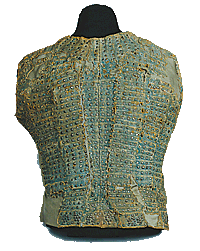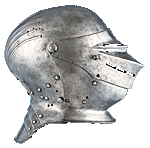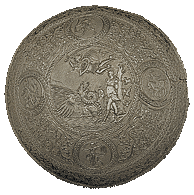In this room, there is a selection of arms and armor
used at the time of the Medici during the period that
goes from the mid-15th century to the end of the 16th.
 The oldest piece, datable to 1450-1470, is a
“corazzina”, a type of armor made of fabric and steel
plates worn both on the battlefield and daily under
heavy coats or doublets, such that one of the
participants in the 1478 Pazzi Conspiracy embraced
Giuliano, the brother of Lorenzo the Magnificent who
was assassinated in the Florentine cathedral, precisely
so as to know if he were wearing one.
The oldest piece, datable to 1450-1470, is a
“corazzina”, a type of armor made of fabric and steel
plates worn both on the battlefield and daily under
heavy coats or doublets, such that one of the
participants in the 1478 Pazzi Conspiracy embraced
Giuliano, the brother of Lorenzo the Magnificent who
was assassinated in the Florentine cathedral, precisely
so as to know if he were wearing one.
 Among the many military innovations carried
forward by Giovanni delle Bande Nere was that of
supplying his soldiers with “horseman’s” helmets; there
is an exemplar on display that comes from a private
collection. It was called a “sallet of Burgundy”
because it was used by the imperial cavalry of Charles
V, which served him under insignias with the crossed
Burgundy vine-props. Also the brass hunting horn is
connected to the great Medici condottiere, it was
commissioned for the 1497 wedding of Giovanni di
Pierfrancesco and Caterina Sforza. In fact, the small
shields of the two families are depicted on the work.
Among the many military innovations carried
forward by Giovanni delle Bande Nere was that of
supplying his soldiers with “horseman’s” helmets; there
is an exemplar on display that comes from a private
collection. It was called a “sallet of Burgundy”
because it was used by the imperial cavalry of Charles
V, which served him under insignias with the crossed
Burgundy vine-props. Also the brass hunting horn is
connected to the great Medici condottiere, it was
commissioned for the 1497 wedding of Giovanni di
Pierfrancesco and Caterina Sforza. In fact, the small
shields of the two families are depicted on the work.
The round shield known as a “buckler” is linked to another wedding. It is covered with embossed boiled leather and was meant to be carried on ceremonial occasions. There is a seated male figure and a standing female one in the center, both wearing laurel wreaths. If the figure dressed in archaic armor was identified up to now as Duke Alessandro (because of similarities in facial features), and therefore the woman standing in front of him as his wife Margaret of Austria, it seems more probable today to recognize in the couple Cosimo I and Eleanor of Toledo.
 Another “buckler”, in leather-covered wood, has
the myth of Perseus Freeing Andromeda in the center,
with an allusion to the early victories of the young
Cosimo who had freed Tuscany from the “monstrous”
rebellion of his opponents. A Cosimo who had chosen for
his own official image, after having taken power, to
have himself portrayed by Bronzino (the painting is
exhibited in the previous room) wearing a light-cavalry
corselet (for use both on foot and on horseback), a
work of the armorer Jörg Seusenhofer, a favorite of the
imperial Hapsburg court. Some parts of the sober armor
are displayed here, together with a metal gauntlet that
also belonged to Cosimo.
Another “buckler”, in leather-covered wood, has
the myth of Perseus Freeing Andromeda in the center,
with an allusion to the early victories of the young
Cosimo who had freed Tuscany from the “monstrous”
rebellion of his opponents. A Cosimo who had chosen for
his own official image, after having taken power, to
have himself portrayed by Bronzino (the painting is
exhibited in the previous room) wearing a light-cavalry
corselet (for use both on foot and on horseback), a
work of the armorer Jörg Seusenhofer, a favorite of the
imperial Hapsburg court. Some parts of the sober armor
are displayed here, together with a metal gauntlet that
also belonged to Cosimo.
In other portraits of him or of his son Francesco, dueling daggers are sometimes seen (to be used together with a sword) like the one exhibited here that could have been produced in Scarperia. There are also parts of a “ceremonial guarniture” that belonged to Francesco I, including a “buckler” portraying the Presentation of Pompey’s Head to Caesar, carried out in Florence by Matteo Piatti, a Milanese craftsman who, already in 1568, had been called to Cosimo’s service in order to start up the local production of armor.
The “foot soldier’s composite corselet”, etched with acid, was worn instead by a knight of Saint Stephen: it displays the grand ducal armorial bearings and the cross of the military order instituted by Cosimo in 1561 in order to defend the Tyrrhenian Sea from the Barbary pirates. A corselet designed to protect from the waist upwards, including the limbs, used both during land service and on the bridge of the grand ducal galleys.


The round shield known as a “buckler” is linked to another wedding. It is covered with embossed boiled leather and was meant to be carried on ceremonial occasions. There is a seated male figure and a standing female one in the center, both wearing laurel wreaths. If the figure dressed in archaic armor was identified up to now as Duke Alessandro (because of similarities in facial features), and therefore the woman standing in front of him as his wife Margaret of Austria, it seems more probable today to recognize in the couple Cosimo I and Eleanor of Toledo.

In other portraits of him or of his son Francesco, dueling daggers are sometimes seen (to be used together with a sword) like the one exhibited here that could have been produced in Scarperia. There are also parts of a “ceremonial guarniture” that belonged to Francesco I, including a “buckler” portraying the Presentation of Pompey’s Head to Caesar, carried out in Florence by Matteo Piatti, a Milanese craftsman who, already in 1568, had been called to Cosimo’s service in order to start up the local production of armor.
The “foot soldier’s composite corselet”, etched with acid, was worn instead by a knight of Saint Stephen: it displays the grand ducal armorial bearings and the cross of the military order instituted by Cosimo in 1561 in order to defend the Tyrrhenian Sea from the Barbary pirates. A corselet designed to protect from the waist upwards, including the limbs, used both during land service and on the bridge of the grand ducal galleys.